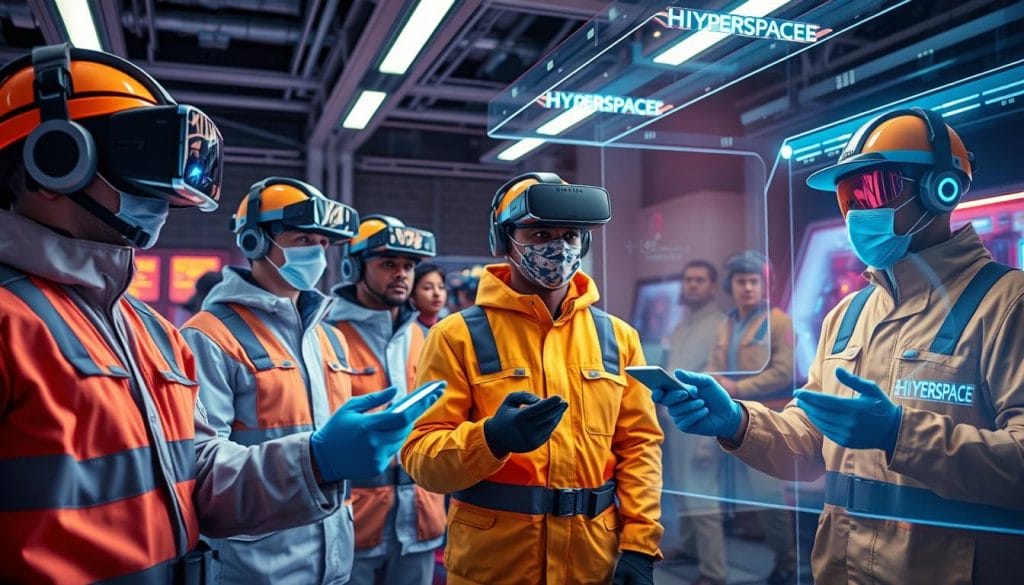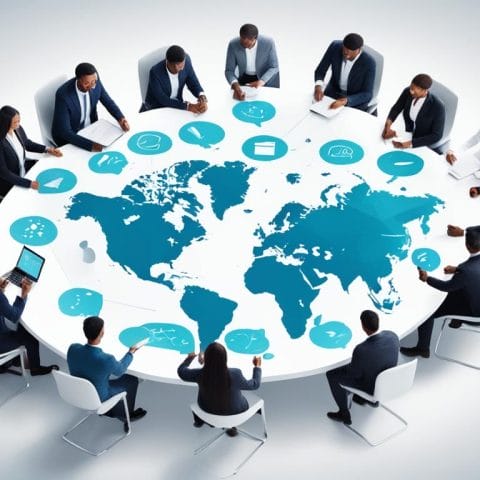Virtual reality (VR) is changing how we train workers. It mixes real-world learning with simulation power. This new tech helps protect frontline workers by preparing them for job challenges.
VR training lets companies see how well their training works. It shows if workers can handle tough situations. It’s not just about safety. It also makes workers better faster, cuts down onboarding time, and boosts customer service.
Key Takeaways
- VR training fuses experiential learning with the power of simulation, transforming corporate training for frontline workers.
- VR technology allows organizations to measure the effectiveness of their training and ensure employees are prepared for real-world scenarios.
- VR training offers a range of benefits beyond just safety, including faster onboarding, improved customer service, and easier culture integration.
- Frontline workers can develop critical skills like hazard awareness, risk mitigation, and crisis management through immersive VR simulations.
- Incorporating VR training has led to a reduction in workplace incidents and accidents, enhancing the overall safety and resilience of frontline teams.
The Importance of Frontline Worker Safety

Workplace safety is a big deal, especially for frontline workers. They work in places like healthcare, warehousing, and retail. They need to spot dangers, follow safety rules, and wear the right gear to stay safe.
Risks and Challenges Faced by Frontline Workers
Recent studies show that many workers feel the job is getting riskier. 58% of employees believe the risk of being physically harmed on the job is rising. 40% reported an increase in concerns about personal safety in the last year.
In healthcare, things are tough. 69% of workers worry about erratic or aggressive patients and visitors, and 59% fear they might be physically assaulted. Retail workers also face dangers, with about 58% of the workforce concerned about customers who behave erratically or aggressively.
Workers near the poverty line are more at risk. They deal with long commutes, more work, not enough sleep, and health issues.
The Impact of Ineffective Training on Worker Safety
Old training methods, like role-playing, don’t prepare workers for big dangers like armed robberies. They need hands-on practice and immersive training to develop the soft skills required to respond automatically in the moment. Bad training can make the job more dangerous, stressful, and lower worker morale.
“Training is critical for frontline workers to gain the confidence and skills needed to respond appropriately to dangerous situations.”
New tech like virtual reality (VR) can help. It lets workers practice in safe, real-like scenarios. This can really improve safety and well-being at work.
Protecting Frontline Workers with VR Training

Organizations are using virtual reality (VR) training to protect frontline workers. VR training lets employees practice important skills in a safe, real-like setting. This way, they can learn without risking themselves or others.
VR training helps workers become more aware of their surroundings. This leads to safer work habits, fewer accidents, and lower costs.
For instance, Verizon has introduced VR safety training in over 1,600 stores. More than 22,000 employees have gone through the 20-minute course. After it, 97% of them felt more ready to face dangerous situations.
This kind of training makes frontline workers more prepared for real-world challenges.
| Company | VR Training Impact |
|---|---|
| Walmart | Cut training time by 96% for new technology proficiency |
| Financial Institution | 10% increase in customer satisfaction ratings within 6 months |
| Sprouts Farmer’s Market | 81% reduction in new hire onboarding time |
| Global Shipping Company | Doubled retention rates for loading dock workers |
Using VR for safety training helps protect frontline workers. It also cuts down on costly accidents. Plus, it makes learning more fun and effective.
Immersive Learning: The Power of Experiential Training
In the world of training frontline workers, immersive learning and experiential training are changing the game. They use realistic VR simulations to give workers the practice they need. This move from classroom learning to hands-on, situational awareness and decision-making exercises is a big change.
Creating Realistic Simulations for Hands-On Practice
New VR technology lets us make realistic simulations that match real-world challenges. Workers can practice in a safe space, making mistakes without real-world risks. This way of learning is better than just sitting in a classroom.
Fostering Situational Awareness and Decision-Making Skills
Immersive learning also helps workers develop situational awareness and decision-making skills. VR training simulates complex scenarios, helping workers learn to assess risks and make quick decisions. This training prepares them to handle the unexpected and make safe, effective choices.
“Immersive learning through VR simulations has transformed the way we train our frontline workers. By providing them with realistic, hands-on experiences, we’ve seen a significant improvement in their confidence, decision-making skills, and overall preparedness for real-world challenges.”
Key Benefits of VR Training for Frontline Workers
Virtual reality (VR) training changes how we train frontline workers. It makes them safer and more productive. By using real-life simulations, VR training offers many benefits.
Improved Workplace Safety and Incident Reduction
VR training is great for keeping workplaces safe. It helps workers in dangerous jobs, like oil and gas, learn safety skills. This reduces the chance of accidents and injuries.
Accelerated Speed to Proficiency and Reduced Onboarding Time
VR training also makes workers learn faster. Traditional training is often boring and doesn’t relate to the job. But VR is interactive and keeps learners interested. This means workers learn quicker and start working sooner.
VR training helps frontline workers reach their full potential. It improves safety, reduces incidents, and speeds up learning. As the need for skilled workers grows, VR training is a key solution for businesses.
Scalability and Consistency in Training Delivery
As remote work grows, VR training is becoming key. It helps solve problems of distance and logistics. It makes sure all workers get the same training, no matter where they are.
Old ways of training don’t work well. They don’t keep information in the minds of learners. But VR training is different. It’s interactive and keeps learners focused. This means training can happen from anywhere, saving money and keeping learning consistent.
Overcoming Geographic and Logistical Barriers
VR training is great for solving distance and logistics issues. With more people working from home, training is harder to manage. VR lets companies give hands-on training to workers everywhere.
This method keeps training effective and makes starting new jobs easier. It helps keep the company’s culture strong. And it makes sure training is as good as it can be.
| Traditional Training Challenges | VR Training Benefits |
|---|---|
| Lower retention rates and ineffective knowledge transfer | Improved information retention and engagement |
| Substantial logistical coordination efforts for large workforces | Seamless remote delivery and scalability |
| Inconsistent training due to disparate approaches | Standardized and consistent learning experiences |
| Wasted time and resources, poor ROI, and demotivated staff | Enhanced efficiency, improved ROI, and engaged employees |
“VR training not only enhances our frontline workers’ skills and preparedness but also ensures a consistent, engaging learning experience across our entire organization, regardless of location.”
Enhancing Customer Service and Employee Engagement
Virtual reality (VR) training does more than just make frontline workers safer. It also boosts customer service and employee engagement. By practicing soft skills like empathy and communication, workers become better at their jobs.
VR also teaches a company’s brand values and culture. This makes frontline employees more engaged and aligned. As a result, they provide better customer service, making the brand experience more positive.
VR-based soft skills training helps workers understand and meet customer needs. This empathetic approach improves the customer experience. It also makes workers feel more valued and empowered.
By using VR training, companies can tackle safety program challenges. This includes issues like disengaged workers or leaders. It helps find incidents and near misses quickly, leading to better safety tracking and decision-making.
“VR training has transformed our frontline employees into brand ambassadors, delivering exceptional customer service while feeling more engaged and connected to our company’s values.”
In the changing world of work, using VR for enhancing customer service and employee engagement is key. It helps companies stay ahead and build a safe, thriving workforce.
Real-World Applications and Success Stories
Many organizations are using virtual reality (VR) training to protect their frontline workers. Verizon and Sprouts Farmer’s Market are two examples of success with VR training.
Verizon’s Armed Robbery VR Training: Protecting Retail Associates
Verizon created a VR training program for its 22,000+ retail associates. It taught them how to handle an armed robbery safely. The training used real security footage to make the simulations feel real.
After the training, 97% of Verizon’s associates felt ready to face dangerous situations. This shows how effective VR training can be.
Sprouts Farmer’s Market: Streamlining Onboarding and Scaling Culture
Sprouts Farmer’s Market used VR to improve its employee onboarding. It cut the time from 4 hours to 45 minutes. This also helped spread the company’s customer-focused culture and values.
This change made onboarding faster and helped Sprouts grow its training as it expanded. These stories highlight VR’s role in protecting workers and boosting success.
Conclusion
Virtual reality (VR) training is changing how we protect frontline workers. It gives them real-life experience in safe environments. This helps them learn and grow, even in tough situations.
VR training has many benefits. It makes workplaces safer and reduces accidents. It also helps workers learn faster and serve customers better.
More companies are seeing the value of VR training. It’s becoming key for keeping frontline workers safe in many fields. From retail to healthcare, VR is a cost-effective way to prepare workers for their jobs.
The future of frontline worker safety looks bright with VR. By using new training methods, companies can support their teams. This leads to better service and a safer work environment.
This article shows how VR training can change the game for frontline workers. They are the backbone of our society, working hard every day. VR training is a game-changer for their safety and success.





